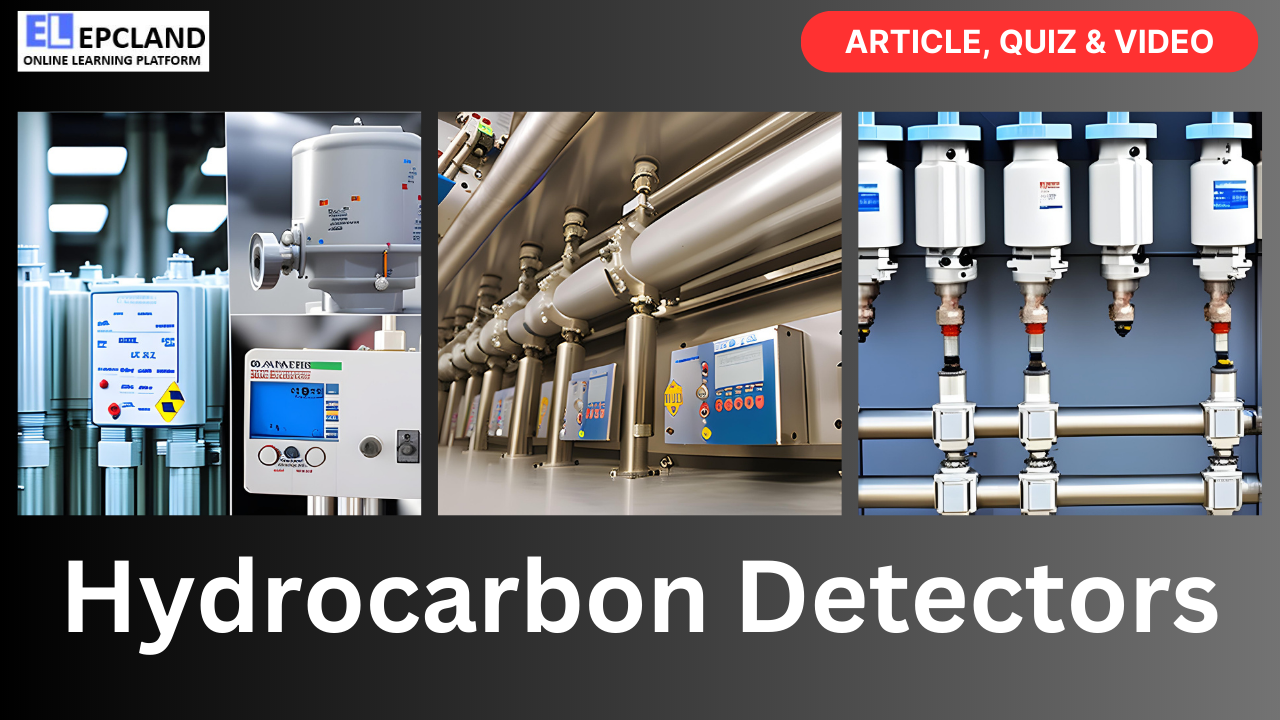The Oil & Gas Industry is known for its vast infrastructure, complex operations, and the inherent risks associated with hydrocarbon exploration, extraction, transportation, and processing. To mitigate these risks, the industry heavily relies on advanced technology, and one crucial component is hydrocarbon detectors. These specialized devices play a pivotal role in ensuring safety, environmental protection, and operational efficiency in oil and gas projects.
Table of Contents
Do not miss the Complete Course on Piping Engineering
By EPCLand
Understanding Hydrocarbons in the Oil & Gas Industry
Before delving into the specifics of hydrocarbon detectors, it’s important to understand what hydrocarbons are and their significance in the industry.
What Are Hydrocarbons?
Hydrocarbons are organic compounds composed of hydrogen and carbon atoms. They are the primary constituents of fossil fuels, including crude oil and natural gas. Hydrocarbons are highly flammable, making them the backbone of the energy industry, but also posing significant safety and environmental risks.
The Role of Hydrocarbons in the Industry
Hydrocarbons are the lifeblood of the Oil & Gas Industry, as they are extracted, refined, and processed to produce various energy products, including gasoline, diesel, jet fuel, and petrochemicals. However, their flammable nature and potential for leakage or spills necessitate stringent safety measures, which is where hydrocarbon detectors come into play.
The Importance of Hydrocarbon Detectors
Hydrocarbon detectors are specialized instruments designed to detect the presence of hydrocarbons in various forms, such as gases or liquids. Their importance in oil and gas projects cannot be overstated:
1. Safety Assurance
Safety is paramount in the Oil & Gas Industry. Hydrocarbon detectors are the first line of defense against gas leaks and potential fires or explosions. Rapid detection allows for swift response measures to protect personnel and assets.
2. Environmental Protection
Hydrocarbon leaks can have devastating environmental consequences, including soil and water contamination. Detectors help prevent and minimize such incidents, reducing the industry’s environmental footprint.
3. Operational Efficiency
Efficient operations are essential for profitability in the Oil & Gas Industry. By promptly detecting leaks or abnormal hydrocarbon levels, detectors contribute to uninterrupted operations and prevent costly shutdowns.
4. Regulatory Compliance
The industry operates under stringent regulations to ensure safety and environmental responsibility. Hydrocarbon detectors help companies meet compliance requirements by providing real-time monitoring and reporting.
Types of Hydrocarbon Detectors
Hydrocarbon detectors come in various types, each designed for specific applications and environments. Here are some common types:
1. Gas Detectors
Gas detectors are instrumental in monitoring hydrocarbon gases such as methane (CH4), ethane (C2H6), propane (C3H8), and butane (C4H10). They are commonly used in drilling rigs, refineries, and natural gas processing facilities.
2. Flame Detectors
Flame detectors are specialized detectors designed to sense the presence of open flames, such as those resulting from gas leaks. They are crucial for rapidly identifying potential fires and initiating safety protocols.
3. Liquid Hydrocarbon Detectors
Liquid hydrocarbon detectors are used to monitor hydrocarbon spills or leaks in liquid form. They are vital for preventing soil and water contamination in storage tank facilities and pipelines.
4. Infrared Detectors
Infrared detectors utilize infrared technology to detect hydrocarbon gases by measuring their absorption of infrared radiation. Each hydrocarbon gas has a unique absorption spectrum, allowing the detector to identify and quantify the gas present.
Do not miss the Complete Course on Piping Engineering
By EPCLand
How Hydrocarbon Detectors Work
To appreciate the functionality of hydrocarbon detectors, it’s essential to understand their operating principles:
1. Gas Detectors
a. Catalytic Sensors
Catalytic gas detectors rely on a catalytic bead coated with a catalyst that promotes the oxidation of hydrocarbons. When hydrocarbons come into contact with the catalyst and react, they produce heat and change the bead’s electrical resistance. This change is detected and triggers an alarm.
b. Infrared Sensors
Infrared gas detectors operate by measuring the absorption of specific infrared wavelengths by hydrocarbon gases. Each hydrocarbon gas has a unique absorption spectrum, allowing the detector to identify and quantify the gas present.
2. Flame Detectors
Flame detectors use various technologies, including ultraviolet (UV), infrared (IR), and multispectrum detectors. UV detectors are sensitive to the UV radiation emitted by a flame, while IR detectors identify the unique IR signature of a flame. Multispectrum detectors combine multiple detection methods for increased accuracy and reliability.
3. Liquid Hydrocarbon Detectors
Liquid hydrocarbon detectors employ various techniques, such as conductivity, capacitance, and optical methods. Conductivity detectors measure changes in electrical conductivity when hydrocarbons come into contact with the sensor. Capacitance detectors monitor changes in capacitance due to the presence of hydrocarbons between two electrodes. Optical detectors use the absorption or scattering of light to detect hydrocarbons in liquids.
4. Infrared Detectors
Infrared detectors use infrared light sources and detectors to measure the absorption of infrared radiation by hydrocarbon gases. The amount of absorbed radiation correlates with the concentration of hydrocarbons in the surrounding atmosphere.
Working Principles of Hydrocarbon Detectors
Hydrocarbon detectors function based on their detection principles. Here’s how some of the common types work:
1. Catalytic Gas Detectors
Catalytic gas detectors operate based on the principle of catalytic combustion. When hydrocarbon gas comes into contact with the catalytic bead coated with a catalyst (typically platinum), it undergoes oxidation, producing heat. This increase in temperature is proportional to the concentration of the hydrocarbon gas, which is then measured by the detector. An alarm is triggered when the temperature rise exceeds a predetermined threshold.
2. Infrared Gas Detectors
Infrared gas detectors rely on the unique absorption spectrum of hydrocarbon gases in the infrared region. The detector emits infrared light at specific wavelengths, and a gas sample is introduced into the measurement chamber. If hydrocarbon gas is present, it absorbs some of the infrared radiation. The remaining light is detected and analyzed to determine the concentration of the gas. By comparing the absorbed and emitted infrared light, the detector can identify the specific hydrocarbon gas.
3. Flame Detectors
Flame detectors use different technologies to detect flames. UV detectors are sensitive to the UV radiation emitted by flames. When a flame is present, the UV detector generates a signal, triggering an alarm. Infrared flame detectors identify the unique infrared signature of flames, particularly the emission of specific wavelengths of infrared light. Multispectrum detectors combine UV and infrared detection methods for increased reliability.
4. Liquid Hydrocarbon Detectors
Liquid hydrocarbon detectors employ various techniques. Conductivity detectors measure changes in electrical conductivity when hydrocarbons are present in a liquid. Capacitance detectors monitor changes in capacitance caused by the introduction of hydrocarbons between two electrodes. Optical detectors use light absorption or scattering to detect the presence of hydrocarbons in liquids. Each method provides a different way of identifying liquid hydrocarbon spills or leaks.
Advantages and Disadvantages of Hydrocarbon Detectors
Let’s summarize the advantages and disadvantages of hydrocarbon detectors in the following table:
| Advantages | Disadvantages |
|---|---|
| Early detection of hydrocarbon leaks and fires | Potential for false alarms |
| Protection of personnel and assets | Regular calibration and maintenance required |
| Prevention of environmental contamination | Sensitivity to environmental conditions |
| Compliance with safety and environmental regs | Compatibility and integration challenges |
| Operational efficiency and cost savings | Limited detection range for some types |
| Real-time monitoring and reporting | High initial costs |
| Predictive maintenance for improved reliability | Limited detection range for some types |
Do not miss the Complete Course on Piping Engineering
By EPCLand
Future Trends and Outlook
As the Oil & Gas Industry continues to evolve, the role of hydrocarbon detectors will remain critical. Several future trends are likely to shape the development and use of these detectors:
1. Enhanced Connectivity
Hydrocarbon detectors will become increasingly connected, enabling seamless integration with digital control systems and providing real-time data to operators and decision-makers.
2. Advanced Sensor Technologies
Advancements in sensor technologies, including nanotechnology and miniaturization, will lead to more compact and sensitive detectors capable of detecting lower concentrations of hydrocarbons.
3. IoT Integration
The Internet of Things (IoT) will play a significant role in the industry’s digital transformation. Hydrocarbon detectors will be part of IoT networks, allowing for centralized monitoring and control of safety systems.
4. Predictive Analytics
The use of predictive analytics and machine learning will become more prevalent, enabling proactive maintenance of hydrocarbon detectors and improving their overall performance.
Conclusion
Hydrocarbon detectors are the unsung heroes of the Oil & Gas Industry, tirelessly working to safeguard personnel, protect the environment, and ensure operational efficiency. Their evolution from simple gas sensors to highly advanced, connected devices reflects the industry’s commitment to safety and innovation. As the industry faces new challenges and opportunities, hydrocarbon detectors will continue to adapt and play a pivotal role in its success.
In this article, we’ve explored the importance of hydrocarbon detectors in the Oil & Gas Industry, their various types and working principles, applications across different industry segments, technological advancements, challenges, and future trends. By staying at the forefront of hydrocarbon detection technology, the industry can mitigate risks and operate more safely and sustainably.
FAQs
1. What are hydrocarbon detectors, and why are they essential in the Oil & Gas Industry?
Hydrocarbon detectors are specialized instruments designed to detect the presence of hydrocarbons, which are the primary components of fossil fuels like crude oil and natural gas. They are essential in the Oil & Gas Industry because they play a crucial role in ensuring safety by detecting gas leaks, preventing fires, protecting the environment from contamination, and maintaining operational efficiency.
2. What types of hydrocarbon detectors are commonly used in the industry, and how do they differ in their applications?
Common types of hydrocarbon detectors include gas detectors, flame detectors, liquid hydrocarbon detectors, and infrared detectors. Each type is designed for specific applications. Gas detectors monitor hydrocarbon gases, flame detectors identify open flames resulting from gas leaks, liquid hydrocarbon detectors detect spills in liquid form, and infrared detectors measure the absorption of infrared radiation by hydrocarbon gases.
3. How do catalytic gas detectors work, and what are their advantages and limitations?
Catalytic gas detectors operate based on catalytic combustion. They use a catalytic bead coated with a catalyst, typically platinum, which promotes the oxidation of hydrocarbons. When hydrocarbons come into contact with the catalyst and react, they produce heat, leading to a change in electrical resistance that is detected and triggers an alarm. The advantages of catalytic gas detectors include their sensitivity and suitability for a wide range of hydrocarbons. However, they may have limitations like the potential for false alarms and the need for regular calibration.
4. Can hydrocarbon detectors be integrated with control systems, and what benefits does this integration offer?
Yes, hydrocarbon detectors can be integrated with control systems such as Distributed Control Systems (DCS) and Supervisory Control and Data Acquisition (SCADA) systems. Integration provides seamless control of safety measures and process shutdowns in the event of a hydrocarbon leak or fire detection. It offers real-time monitoring, remote control capabilities, and data logging for analysis, enhancing overall safety and operational efficiency.
5. What are the emerging trends and future developments in hydrocarbon detection technology for the Oil & Gas Industry?
Emerging trends in hydrocarbon detection technology include enhanced connectivity, advanced sensor technologies, integration with the Internet of Things (IoT), and the use of predictive analytics and machine learning. These trends aim to improve real-time monitoring, reduce false alarms, enhance sensor reliability, and enable predictive maintenance, ensuring that hydrocarbon detectors continue to evolve to meet the industry’s evolving needs for safety and efficiency.
Do not miss the Complete Course on Piping Engineering
By EPCLand
Recommended courses (Published on EPCLand)
- Basics of Piping Engineering
- Piping Layout Engineering
- Piping Material Engineering
- Piping Stress Analysis
- Complete Course on Piping Engineering
- Material Requisitions
- Piping Material Specifications
- Valve Material Specifications
Don’t miss the published articles on following:
Related Video
Attempt Quiz
Question 1:
What is the primary purpose of hydrocarbon detectors in oil & gas projects?
Explanation: Hydrocarbon detectors in oil & gas projects are primarily used to detect the presence of hydrocarbon gases, which helps in safety and early warning systems.
Question 2:
Which type of hydrocarbon detector relies on catalytic oxidation for sensing?
Explanation: Flame ionization detectors rely on catalytic oxidation for sensing hydrocarbon gases.
Question 3:
Which hydrocarbon detector is commonly used for detecting volatile organic compounds (VOCs)?
Explanation: Photoionization detectors are commonly used for detecting volatile organic compounds (VOCs) in oil & gas projects.
Question 4:
What is the advantage of using infrared hydrocarbon detectors?
Explanation: The advantage of using infrared hydrocarbon detectors is selective detection of specific gases, making them useful for identifying particular hydrocarbons.
Question 5:
What is the role of hydrocarbon detectors in gas leak detection systems?
Explanation: Hydrocarbon detectors in gas leak detection systems are used to alert operators and trigger safety measures in the event of a gas leak, helping to prevent accidents and ensure safety.



